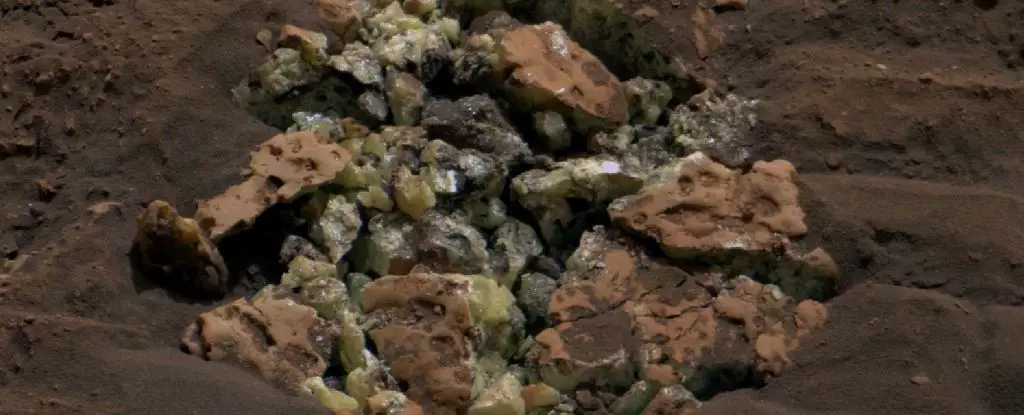In a remarkable twist of fate, NASA’s Curiosity rover introduced an astonishing revelation during its exploration of Mars in May: the discovery of elemental sulfur in its purest form. While studying a seemingly mundane rock, the rover’s weight caused it to crack open, exposing vivid yellow crystals of brimstone nestled within. This incident is more than just a moment of curiosity; it represents a momentous scientific milestone as the first detection of pure elemental sulfur on the Martian surface, despite the well-established presence of sulfates on the planet.
Curiosity’s findings occurred in the Gediz Vallis Channel—a geological feature that hints at a rich history of water flow and possibly life-supporting conditions in the past. The implications of this discovery stretch far beyond mere novelty; it opens the door to a multitude of questions about the geological processes that govern Mars and the potential implications for astrobiology.
Elemental sulfur’s rarity on Mars is compelling considering the known characteristics of the Martian environment. Traditionally, sulfur exists in various compound forms, such as sulfates, which are formed from heating or chemically altering existing minerals in the presence of water. This transformation offers insights into the planet’s ancient hydrological history and its long-term climate changes. The sudden emergence of unadulterated elemental sulfur requires scientists to reassess their understanding of local geological processes. As Ashwin Vasavada from NASA aptly described, “Finding a field of stones made of pure sulfur is like finding an oasis in the desert.” This is an assertion that speaks volumes about the paradoxical nature of Martian geology.
Pure sulfur emerges under a very specific set of conditions that have not been definitively identified on Mars. Its appearance in this form amplifies the intrigue, suggesting that either a previously unknown geological process is at play, or that Mars holds secrets yet to be uncovered. So far, these findings compel scientists to stretch the limits of conventional knowledge on the Red Planet.
One cannot dismiss the tantalizing implications of this discovery regarding the potential for life on Mars. Although the presence of sulfates did not immediately indicate biological activity, discovering the elemental cousin of sulfur—an essential element for life—captures attention. Sulfur is critical in a variety of biological functions, chiefly in the formation of amino acids that are foundational to protein synthesis. For astrobiologists, such as those analyzing Curiosity’s data, the presence of these foundational chemical building blocks raises questions about Mars’s past habitats and the conditions that may have fostered living organisms.
Since the rover has been traversing terrains that were presumably once submerged, the potential for discovering fossils or remnants of ancient Martian life remains tantalizingly within reach. While Curiosity has not uncovered direct signs of life, the ongoing exploration of these sulfur-rich terrains hints at a landscape shaped by historical water movements, presenting the necessary conditions for past microbial organisms to thrive.
With Curiosity continuing its mission, the path forward entails performing complex geological assessments to explain the peculiar presence of sulfur in its pure form. The next phase of this investigation includes comprehensive modeling of Mars’s geological evolution alongside careful examination of the mineral compositions in the Gediz Vallis Channel. Curiosity’s current mission has positioned it to collect further data that can refine our understanding of the planet’s past.
Simultaneously, the rover’s work holds particular importance for human exploration in the coming decades. Understanding the geological history of water on Mars is crucial when considering potential colonization. As scientists decode the chemical signatures left behind in the dusty Martian soil, they can better gauge the planet’s capability to host life—past, present, or future.
The discovery of elemental sulfur on Mars signifies more than geological curiosity; it encapsulates the essence of the exploration spirit. Each finding promotes the notion that scientific journeys will often lead us down the path of the unexpected, challenging existing knowledge and sparking renewed enthusiasm for planetary discovery. This discovery serves as a reminder of the vast, untapped potential that remains within our reach as we endeavor to understand the mysteries of Mars and the universe beyond.


Leave a Reply